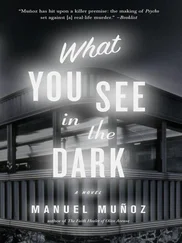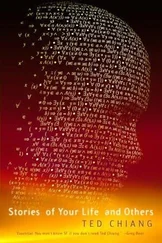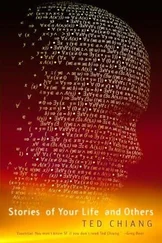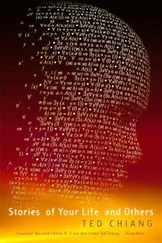Ted Chiang - Liking What You See - A Documentary
Здесь есть возможность читать онлайн «Ted Chiang - Liking What You See - A Documentary» весь текст электронной книги совершенно бесплатно (целиком полную версию без сокращений). В некоторых случаях можно слушать аудио, скачать через торрент в формате fb2 и присутствует краткое содержание. Жанр: Фантастика и фэнтези, на английском языке. Описание произведения, (предисловие) а так же отзывы посетителей доступны на портале библиотеки ЛибКат.
- Название:Liking What You See: A Documentary
- Автор:
- Жанр:
- Год:неизвестен
- ISBN:нет данных
- Рейтинг книги:4 / 5. Голосов: 1
-
Избранное:Добавить в избранное
- Отзывы:
-
Ваша оценка:
- 80
- 1
- 2
- 3
- 4
- 5
Liking What You See: A Documentary: краткое содержание, описание и аннотация
Предлагаем к чтению аннотацию, описание, краткое содержание или предисловие (зависит от того, что написал сам автор книги «Liking What You See: A Documentary»). Если вы не нашли необходимую информацию о книге — напишите в комментариях, мы постараемся отыскать её.
Liking What You See: A Documentary — читать онлайн бесплатно полную книгу (весь текст) целиком
Ниже представлен текст книги, разбитый по страницам. Система сохранения места последней прочитанной страницы, позволяет с удобством читать онлайн бесплатно книгу «Liking What You See: A Documentary», без необходимости каждый раз заново искать на чём Вы остановились. Поставьте закладку, и сможете в любой момент перейти на страницу, на которой закончили чтение.
Интервал:
Закладка:
Liking What You See: A Documentary
by Ted Chiang
“Beauty is the promise of happiness.”-Stendhal
Tamera Lyons, first-year student at Pembleton:
I can’t believe it. I visited the campus last year, and I didn’t hear a word about this. Now I get here and it turns out people want to make calli a requirement. One of the things I was looking forward to about college was getting rid of this, you know, so I could be like everybody else. If I’d known there was even a chance I’d have to keep it, I probably would’ve picked another college. I feel like I’ve been scammed.
I turn eighteen next week, and I’m getting my calli turned off that day. If they vote to make it a requirement, I don’t know what I’ll do; maybe I’ll transfer, I don’t know. Right now I feel like going up to people and telling them, “Vote no.” There’s probably some campaign I can work for.
Maria deSouza, third-year student, President of the Students for Equality Everywhere (SEE):
Our goal is very simple. Pembleton University has a Code of Ethical Conduct, one that was created by the students themselves, and that all incoming students agree to follow when they enroll. The initiative that we’ve sponsored would add a provision to the code, requiring students to adopt calliagnosia as long as they’re enrolled.
What prompted us to do this now was the release of a spex version of Visage. That’s the software that, when you look at people through your spex, shows you what they’d look like with cosmetic surgery. It became a form of entertainment among a certain crowd, and a lot of college students found it offensive. When people started talking about it as a symptom of a deeper societal problem, we thought the timing was right for us to sponsor this initiative.
The deeper societal problem is lookism. For decades people’ve been willing to talk about racism and sexism, but they’re still reluctant to talk about lookism. Yet this prejudice against unattractive people is incredibly pervasive. People do it without even being taught by anyone, which is bad enough, but instead of combating this tendency, modern society actively reinforces it.
Educating people, raising their awareness about this issue, all of that is essential, but it’s not enough. That’s where technology comes in. Think of calliagnosia as a kind of assisted maturity. It lets you do what you know you should: ignore the surface, so you can look deeper.
We think it’s time to bring calli into the mainstream. So far the calli movement has been a minor presence on college campuses, just another one of the special-interest causes. But Pembleton isn’t like other colleges, and I think the students here are ready for calli. If the initiative succeeds here, we’ll be setting an example for other colleges, and ultimately, society as a whole.
Joseph Weingartner, neurologist:
The condition is what we call an associative agnosia, rather than an apperceptive one. That means it doesn’t interfere with one’s visual perception, only with the ability to recognize what one sees. A calliagnosic perceives faces perfectly well; he or she can tell the difference between a pointed chin and a receding one, a straight nose and a crooked one, clear skin and blemished skin. He or she simply doesn’t experience any aesthetic reaction to those differences.
Calliagnosia is possible because of the existence of certain neural pathways in the brain. All animals have criteria for evaluating the reproductive potential of prospective mates, and they’ve evolved neural “circuitry” to recognize those criteria. Human social interaction is centered around our faces, so our circuitry is most finely attuned to how a person’s reproductive potential is manifested in his or her face. You experience the operation of that circuitry as the feeling that a person is beautiful, or ugly, or somewhere in between. By blocking the neural pathways dedicated to evaluating those features, we can induce calliagnosia.
Given how much fashions change, some people find it hard to imagine that there are absolute markers of a beautiful face. But it turns out that when people of different cultures are asked to rank photos of faces for attractiveness, some very clear patterns emerge across the board. Even very young infants show the same preference for certain faces. This lets us identify the traits that are common to everyone’s idea of a beautiful face.
Probably the most obvious one is clear skin. It’s the equivalent of a bright plumage in birds or a shiny coat of fur in mammals. Good skin is the single best indicator of youth and health, and it’s valued in every culture. Acne may not be serious, but itlooks like more serious diseases, and that’s why we find it disagreeable.
Another trait is symmetry; we may not be conscious of millimeter differences between someone’s left and right sides, but measurements reveal that individuals rated as most attractive are also the most symmetrical. And while symmetry is what our genes always aim for, it’s very difficult to achieve in developmental terms; any environmental stressor—like poor nutrition, disease, parasites—tends to result in asymmetry during growth. Symmetry implies resistance to such stressors.
Other traits have to do with facial proportions. We tend to be attracted to facial proportions that are close to the population mean. That obviously depends on the population you’re part of, but being near the mean usually indicates genetic health. The only departures from the mean that people consistently find attractive are ones caused by sex hormones, which suggest good reproductive potential.
Basically, calliagnosia is a lack of response to these traits; nothing more. Calliagnosics arenot blind to fashion or cultural standards of beauty. If black lipstick is all the rage, calliagnosia won’t make you forget it, although you might not notice the difference between pretty faces and plain faces wearing that lipstick. And if everyone around you sneers at people with broad noses, you’ll pick up on that.
So calliagnosia by itself can’t eliminate appearance-based discrimination. What it does, in a sense, is even up the odds; it takes away the innate predisposition, the tendency for such discrimination to arise in the first place. That way, if you want to teach people to ignore appearances, you won’t be facing an uphill battle. Ideally you’d start with an environment where everyone’s adopted calliagnosia, and then socialize them to not value appearances.
Tamera Lyons:
People here have been asking me what it was like going to Saybrook, growing up with calli. To be honest, it’s not a big deal when you’re young; you know, like they say, whatever you grew up with seems normal to you. We knew that there was something that other people could see that we couldn’t, but it was just something we were curious about.
For instance, my friends and I used to watch movies and try to figure out who was really good-looking and who wasn’t. We’d say we could tell, but we couldn’t really, not by looking at their faces. We were just going by who was the main character and who was the friend; you always knew the main character was better-looking than the friend. It’s not true a hundred percent of the time, but you could usually tell if you were watching the kind of thing where the main character wouldn’t be good-looking.
It’s when you get older that it starts to bother you. If you hang out with people from other schools, you can feel weird because you have calli and they don’t. It’s not that anyone makes a big deal out of it, but it reminds you that there’s something you can’t see. And then you start having fights with your parents, because they’re keeping you from seeing the real world. You never get anywhere with them, though.
Читать дальшеИнтервал:
Закладка:
Похожие книги на «Liking What You See: A Documentary»
Представляем Вашему вниманию похожие книги на «Liking What You See: A Documentary» списком для выбора. Мы отобрали схожую по названию и смыслу литературу в надежде предоставить читателям больше вариантов отыскать новые, интересные, ещё непрочитанные произведения.
Обсуждение, отзывы о книге «Liking What You See: A Documentary» и просто собственные мнения читателей. Оставьте ваши комментарии, напишите, что Вы думаете о произведении, его смысле или главных героях. Укажите что конкретно понравилось, а что нет, и почему Вы так считаете.











